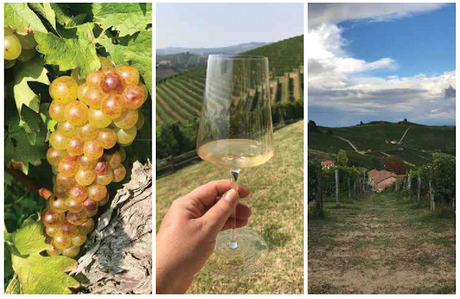A recent visit to the Piedmont region of Italy nurtured my understanding of the distinctive and honorableMoscato Bianco grape from which the best Moscato d’Asti wines are made. The wine has a distinctivelyintense, musky aroma of the grapes it is made from and is one of the characteristic products of Piedmontese winemaking along with Barolo and Barbaresco. Its delicate flavor is reminiscent of wisteria and linden, peach, and apricot, with hints of sage, lemon, and orange blossom.
 In order to preserve the integrity of the Moscato Bianco varietal, define the region of origin, and mostimportantly to protect the product quality, the Consorzio dell’ASTI DOCG was established in 1932 and named for the province where the grapes were grown. Under Italian wine law, DOCG (Denomination of Controlled and Guaranteed Origin) is the highest designation of quality among Italian wines. The Consorzio coordinates and promotes activities that validate the area of origin of Moscato Bianco grapes whose agronomy covers approximately 24,000 acres of which 3,500 acres have a grade over 40% where no mechanical equipment can be used, and vines must be tended exclusively by hand. “Moscato grapes have been grown in the Asti province for more than 500 years and our system of vinification is more than 250 years old,” explains Stephano Chiarlo, fourth-generation winemaker at Michele Chiarlo Winery. “The DOCG is vital to protect our land, our community of family farmers, and our cultural heritage.” The Consorzio's role also includes quality control along the entire production process and monitoring the use of the designation name to prevent counterfeiting and wine fraud.
In order to preserve the integrity of the Moscato Bianco varietal, define the region of origin, and mostimportantly to protect the product quality, the Consorzio dell’ASTI DOCG was established in 1932 and named for the province where the grapes were grown. Under Italian wine law, DOCG (Denomination of Controlled and Guaranteed Origin) is the highest designation of quality among Italian wines. The Consorzio coordinates and promotes activities that validate the area of origin of Moscato Bianco grapes whose agronomy covers approximately 24,000 acres of which 3,500 acres have a grade over 40% where no mechanical equipment can be used, and vines must be tended exclusively by hand. “Moscato grapes have been grown in the Asti province for more than 500 years and our system of vinification is more than 250 years old,” explains Stephano Chiarlo, fourth-generation winemaker at Michele Chiarlo Winery. “The DOCG is vital to protect our land, our community of family farmers, and our cultural heritage.” The Consorzio's role also includes quality control along the entire production process and monitoring the use of the designation name to prevent counterfeiting and wine fraud.So, what makes Italy’s Moscato d'Asti DOCG wines so special? The characteristic floral, perfumed aromas come from the actual Moscato grapes rather than scents derived from the winemaking process. While it is slightly effervescent, Moscato d'Asti DOCG is technically not a sparkling wine, as it only undergoes partial fermentation in steel vats so that the intricacies of the delicate fruit are not lost. Fermentation is terminated when an alcohol content no more than 5% by volume is reached. The use of cold chain technology in the production process means the aromas and flavors of the grapes are preserved and the product can be stabilized, ready for storage, and transportation. The best examples tend toward a soft yellow or a pale gold and unite bright fruitiness, a gentle creaminess, and a refreshing finish. This is a wine that does not benefit from aging in oak barrels. While some wineries are experimenting with cellaring their vintages, in general, Moscato d’Asti should be consumed upon its release to market.
The most notable thing about Moscato d’Asti DOCG is its versatility. Frequently rejected as being “too sweet,” this wine is the perfect complement to most seasonal meals. Refreshing and cool in the Summer months with brunch or apps by the pool, it also pairs remarkably well with holiday dishes like spiced-rubbed turkey and savory dressing, spiral-sliced ham, and tangy mustard, or best with the perfectly constructed cheese board of Italian cheeses and charcuterie. Serve the best, forget the rest – Cin Cin!

